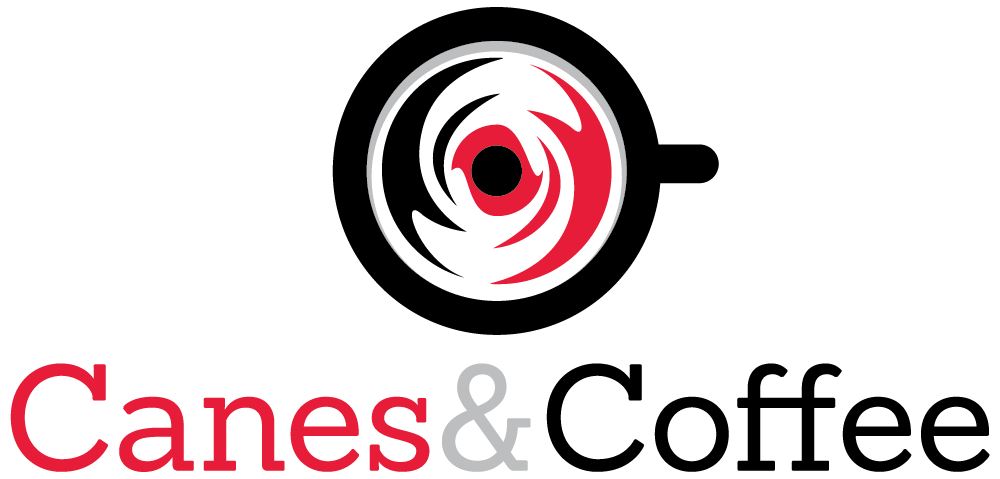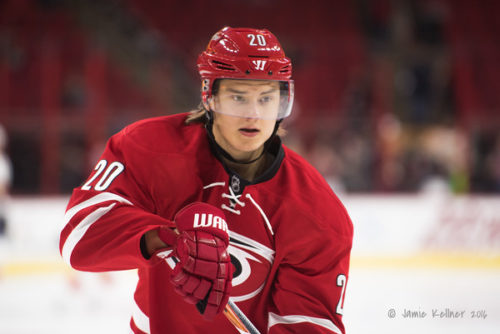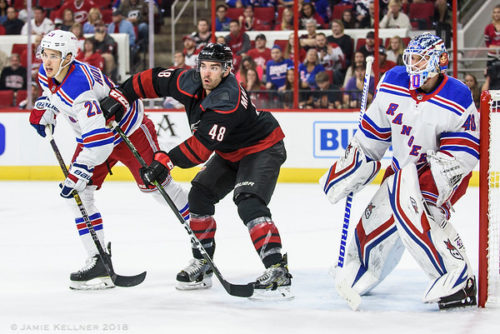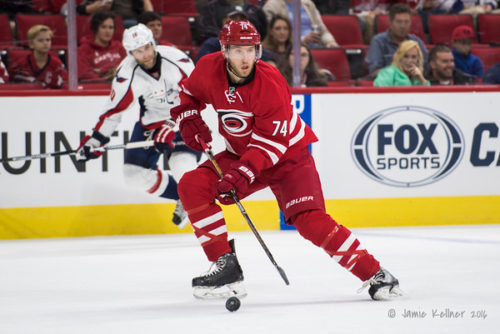After a day off to consider how well the Carolina Hurricanes have done at avoiding risky/bad next contracts under Don Waddell over the past two years, today’s Daily Cup of Joe is back on my previous goalie beat.
Part 2 considered free agent options in Braden Holtby, Jacob Markstrom and Anton Khudobin.
Today’s part 4 is well-timed with the broader NHL media on the ‘Canes might add a goalie’ train today with Pierre LeBrun from The Athletic including James Reimer in his article listing players who could be traded (subscription required). With Alex Nedeljkovic waiting in the wings, trading Reimer does not automatically mean that the Hurricanes would add an upgrade in net, but it definitely paves the way.
This category of goalie options considers a couple netminders who are under contract for the 2020-21 season or beyond and could be a longer-term option in net.
Crazy effect of the 2020 playoffs
Before I jump into more Canes specifics, let me take a short turn as a beat writer for the broader NHL.
Especially considering the unprecedented lead up with five months off before parachuting directly into playoff hockey, the 2020 NHL Playoffs have had a bizarre impact on the near-term market for goalies. Had I told you in February that the off-season would cause permanent fixture type starters Marc-Andre Fleury, Ben Bishop, Jacob Markstrom and maybe even (though less likely) Tuuka Rask to be entered into the off-season goalie market, you would have told me that it would be more likely that the NHL playoffs would be played in August and September.
And here we are.
In Las Vegas, the playoffs seemed to take one goalie off the market in Robin Lehner and possibly add another to the market in Marc-Andre Fleury.
In Vancouver, Jacob Markstrom went from being nearly certain to be re-signed by the Canucks to possibly being replaced by playoff up-and-comer Thatcher Demko, putting Markstrom on the market.
In Dallas, Anton Khudobin went from being a capable but maybe not incredibly unique veteran backup goalie to a potential Conn Smyth Trophy-winner and hot free agent commodity. If Dallas decides to re-sign Khudobin and keep riding him into the 2020-21 season, there are now rumblings that Ben Bishop could hit the trade market.
In Boston, Tuuka Rask, who has had his ups and downs with the Bruins, opted out of the bubble midway through the team’s first playoff series. Nothing is certain on this one, but could that see Boston move on a year before Rask’s contract expires.
In Toronto, another disappointing first-round exit sees Maple Leafs General Manager Kyle Dubas trying to pull levers to get his team over the hump. Part of that is Frederik Andersen’s being in the rumor mill very shortly after the Leafs’ playoff dismissal.
In Arizona, Darcy Kuemper went from being a good but not especially interesting backup (very similar to Khudobin) to being the next flavor of the month as a career backup who was suddenly ready to be a starter.
Darcy Kuemper with the Arizona Coyotes
Darcy Kuemper was specifically mentioned in LeBrun’s article as possibly being of interest to the Hurricanes. He still carries all of the glow from playing a stretch of strong hockey in the spotlight of the playoffs. He is only 30 years old which means if things work out in the last year of his current contract in 2020-21 he could become a longer-term option. And since he has never been a full-time starter, he does not have any of the negative marks that most starting goalies have from the ups and downs of being a goalie in the NHL.
And therein lies the problem or at least significant risk with Darcy Kuemper. To become a capable or better starting goalie for the Carolina Hurricanes, Kuemper would need to navigate two sizable hurdles. First, he would need to make the transition to a new team. Second, he would need to navigate the transition from being a #2 goalie or the guy who is filling in at #1 because the #1 is hurt to being a #1. I think people navigate how challenging both of these transitions are individually for the goalie position and even more so how challenging it can be to navigate both at the same time. When a skater joins a new team and starts slow, the coach can ease him into a slightly lesser role and dial up minutes and responsibilities as warranted. A team has 17 other skaters who can pick up slack in scoring, defending or whatever. In that vein, Vincent Trocheck arrived from Florida at the trade deadline and played decent hockey but struggled a bit scoring-wise. Despite Trocheck’s slow start, the Canes in total did not really miss a beat, and Trocheck somewhat quietly just kept working get his feet under him in a new situation. But in that same situation of a slow start or tough stretch for a starting goalie, there is nowhere to hide. In net a slow start tags a loss to the goalie’s record with each failed outing, and five or six losses can pile up quickly. At that point, the pressure quickly becomes immense. Similarly, the pressure on an NHL starter is significantly different than on a backup or even 1B. As a backup, if you play well, you see more starts. If you play poorly, you maybe get a longer break and fewer starts. The result is that coaches tend to play backups a bit more when things are going well and can give them time to regroup when things do not go well. As a starter, that is not so much the case. Sometimes there can be reprieve from a backup or 1B carrying a slightly bigger load, but the starter is much more so forced to play his way through slumps.
People might try to point to extenuating circumstances , but Scott Darling was very much a match for Kuemper’s situation. Darling was an older goalie who had never really been a starter except filling in for an injury but had truly excelled in his role. The consensus on Darling when the Hurricanes acquired him was that he was ready for a starter’s role. He seemed to struggle a bit acclimating to a new team, system and environment. Then when things started slowly after an injury, the pressure of the contract and responsibility of being a #1 with nowhere to hide seemed to eat whatever confidence, rhythm or whatever else helped Darling succeed in Chicago. He never recovered.
Playing goalie as a backup, 1B or injury fill in #1 is nothing close to the same as carrying the weight of being expected to be a #1.
In my book, all goalies are some combination of voodoo, black magic and snake oil, so there is risk with any option. In that regard, this is not to say that Kuemper would be certain to fail. Rather, my is to say that Kuemper comes with significantly more ‘transition risk’ than a more established starter who has at least navigated the pressure and the different role.
Ben Bishop with the Dallas Stars
Ben Bishop is an odd name to see on a list like this. More than anything, he is the victim of the weird goalie-affected playoffs. Bishop had a respectable regular season with a .920 save percentage, 2.50 goals against average and 21-16-4 record and entered the playoffs as the Stars starting goalie. Then he was injured and ceded the starting role to Anton Khudobin who has never looked back. Now there are rumblings that the Stars might re-sign Khudobin who is a free agent this summer and trade Bishop to save salary at the goalie position. At a basic level, Bishop is an experienced #1 goalie, but he will also be 34 years old when the next season starts and has missed a good chunk of time to injuries in recent years. If willing to accept the age and injury risks, the $4.9 million per year for three more years on his contract is a reasonable price for a #1 goalie in today’s NHL.
Matt Murray with the Pittsburgh Penguins
Matt Murray represents an interesting option who is unique in a few ways. First, whereas most of the available options are north of 30 years old, Murray is only 26 years old. And with two Stanley Cup wins under his belt already, Murray is battle tested in the playoffs. But that begs the question of why he is likely available via trade with the Penguins. After bursting onto the scene with rookie playoff success a bit like Cam Ward, Murray has had some ups and downs as a starting goalie. His 2019-20 campaign was sub-par with a meager .899 save percentage that yielded his starting job to Tristan Jarry. On the surface, I really like the idea of Murray just being a victim of the Penguins’ ‘iffy’ defense and being primed for a rebound playing behind a superior Hurricanes blue line. But that does not seem to hold water when seeing the fact that Tristan Jarry had a strong 2019-20 season playing behind the same defense. He is a restricted free agent, so he would need to re-signed upon acquisition for a few years. Because of his young age, the high points of his track record and his current downward trajectory, Murray could have the widest of range of possible outcomes with a really high ceiling and a similarly low floor. Acquiring and committing to him would seem to be a high stakes bet that relies on the scouting staff to determine which direction he goes from here.
What say you Canes fans?
1) Do you like Darcy Kuemper despite the risk of transition to a new team and #1 role at the same time a bit like Scott Darling a few years back?
2) What do you make of Ben Bishop? The injury issues are a concern, but unlike most of the higher-end veterans on this list, he did not so much find himself on the trade market because his play warranted it?
3) Any chance that Matt Murray just needs a change of scenery and a better defense to have a Marc-Andre Fleury rejuvenation post-Penguins?
Go Canes!




Well I really liked the idea of trading for Kuemper until you drew the parallels to Darling and now I’m full of doubt. Didn’t he get basically get starter’s minutes this season though?
There’s also the option that Kuemper would come in and share the net with Mrazek. If one goalie gets hot, he gets more starts until something changes.
I’d be nervous about signing a 34yo goalie, but Bishop would be intriguing for the right price.
I’d pass on Murray, especially to gamble on his rebound when we have Reimer and Mrazek under contract for next season.
Kuemper held the starting jump for most of the 2018-19 season (because Raanta was out long-term with injury) and played very well. In 55 games, he was 27-20-8 with a .925 save percentage. Some would argue that that is proof that he can handle a starting role, my assertion above is that the mental challenge/pressure just are not the same thing when a goalie is filling in even if long-term.
Otherwise, Kuemper has been a good #2 throughout his career never with more than 30 starts.
No guarantees any which direction with goalies, but I think that ‘transition to starter’ risk is underaccounted for with good backups.
Stop the madness. If the goal is to win a Stanley Cup, then bringing in a goalie hasn’t worked in more than a decade. Lehner was brought in to a team that made it to finals just two years ago, a team that had also added two top forwards since then, and Vegas will not be winning the Cup. The teams that still have a chance feature a goalie drafted by the organization and an itinerant goalie who was not scheduled to play in the playoffs.
As Matt states “goalies are some combination of voodoo, black magic and snake oil.” Voodoo has some traditions and snake oil can be analyzed for its components. Recent hockey history makes a strong case that one of the key ingredients in goalie success in a run to the Stanley Cup is coming from within the organization. Some have solid careers with one organization (Quick, Crawford, Holtby) and some have great playoff runs (Binnington, Murray, Ward). The one thing they have in common is that none of them was “the last piece” that was brought into the winning team.
My theory is that goalies’ psyches are such that having an organization identify you when you are 17 and stick with you for 5-15 years helps with all the demons created by the position.
So the discussion to have is how many starts does Ned need this year and, if there is an AHL season, should Booth and Makiniemi split the role in Chicago (typed Charlotte then had to correct) or does the Finn get the “next up” designation until he falters repeatedly.
Murray is young and talented, and the extraneous criticism(s) typically apply to ALL GOALIES! It’s a crap-shoot, but the youth and record will get you a starter for the future, and even if he falters…he could be traded AGAIN! …no-brainer, IMO!
Despite (possibly because of) the fact I haven’t seen him play much Kuemper would be the only one of the goalies listed in the last few days that really interests me. Largely because I think continuing the moderately paid 1A 1B option is our best bet moving through the flat cap, expansion draft and Hamilton/Svech extensions.
The Hurricanes current system leads to some dangerous lapses that can drive a goalie’s numbers down, but we’ve seen solid performances from three consecutive “reclamation projects” under HCRBA & company. That leads me to believe most NHL caliber tenders will be able to be moderately successful with the team.
Assuming a top tier goaltender in a new system could cover those lapses is a gamble and could still prove costly even considering the glut of talent that would possibly be available.
The armchair GM in me says focus on keeping the core together through the expansion draft/flat cap contract extensions, if a chance for an upgrade in net presents itself at a low cost take it and hope Askarov falls/Kotchetkov has a bounce back year.
Not a particular fan of any of these goalies, not convinced they would present any sort of upgrade over the current goalie trio (except in cost).
Not really interested in Bhishop or Murray. Bhishop is getting old and injury prone, Murray.
I get the comparison between Darling and Kuemper. Darling had 80 starts vs 235 for Kuemper. Kuemper has now put together 3 straight excellent seasons.
So less risk especially with just 2 years left on his contract. Depends on his price.
Askarov already has a SO in the KHL so getting him looks less likely.
I tend to agree with ct that we don’t have to do anything. I also like his theory on grooming goalies internally. So it would seem that to lower your risk you either take an established goalie who has successfully transitioned to another team before (ie., MA Fleury) or you find someone young and promising (ie., Merlinkins).
However, I disagree with ct that we do have to do something: both our goalies are UFA’s after this season so we’d have to extend one of them or expose Ned in the Expansion draft, and in the case Ned was picked, we’d have no goalies under contract or in the system.
Two other important points. First, there does seem to be a lot of goalies on the market – more than usual. And second, there is a flat Cap and no real optimism that it will rise materially any time soon. Both should help to drive down the price of any option that might significantly reduce longer-term risk.
We’re likely to do something. GMDW has had a hot hand finding goalies so I tend to trust the brain-trust in this area.
Hmm, I never thought about it like that, i.e. the Canes have two expiring goalie contracts this year.
If so, the first question is whether the team wants to resign one or both of the goalies they have, or if they are not satisfied with what they got.
Reimer is a potential trade chip (with low actual salary and the Canes potentially able to retain a lot of his cap in a trade, a cap strapped team looking for a backup goalie with experience may want someting like that, depending on the return).
If we traded for one of the goalies on the market it must mean that Mrazek is not in the longer term plans (given his salary and expectations).
It kind of puts the whole discussion in a bit of a new light for me, not necessarily new conclusions, not yet.
An article over on HB is matching the Canes with Cory Crawford.